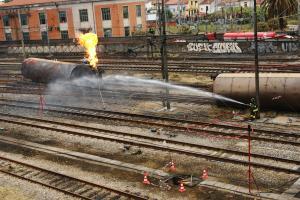
RAILWAY: EN 45545 SERIES AT A GLANCE
Wednesday 13 July 2022
EN 45545 objectives
The measures and requirements specified in EN 45545 are intended to protect passengers and staff in railway vehicles in the event of a fire on board.
The ultimate objective in the event of a fire on board is to allow passengers and staff to evacuate the railway vehicle and reach a place of safety.
EN 45545 series
- Part 1: General
- Part 2: Requirements for fire behavior of materials and components
- Part 3: Fire resistance requirements for fire barriers
- Part 4: Fire safety requirements for railway rolling stock design
- Part 5: Fire safety requirements for electrical equipment
- Part 6: Fire control and management systems
- Part 7: Fire safety requirements for flammable liquid and flammable gas installations
Active or passive fire protection?
- Part 1, 2, 3, 4, 5, 7 Passive fire protection
- Part 6 Active fire protection
EN 45545 Part 1: General
- Mainly definition of the operation category
- HL Category has been defined by the operator
- Design category has been defined by operator
- Operational concept regarding running time necessary
EN 45545 Part 2: Requirements for fire behaviour of materials and components
- Most extensive part of the standard: 26 requirements, associating 17 fire tests
- HL definition determined by operator
- Nearly every component of the vehicle has to be considered
- Note the general rules and the grouping rules
- Test Reports (also classification reports) from accredited testing institutes are required (note: data sheets as evidence are not permitted)
EN 45545 Part 2: Requirements for fire behaviour of materials and components
- Module
- Component
- Exact structure of the component
- Requirement according to EN 45545-2 (setpoint)
- Result according to EN 45545-2 (actual value)
- Verification with link (e.g. test report with test institute, report number and date)
- Exposed area
- Flammable mass
- Calorific value
- Resulting fire load
Part 3: Fire resistance requirements for fire barriers Identified areas according to table 1 (e.g. underfloor technical cabinet)
Test according to
- EN 1363-1
- EN 1364-1
- EN 1364-2
Note: Important for the test sample(s) is to consider all penetrations an the surrounding structure
Part 4: Fire safety requirements for railway rolling stock design
- Main Headline: Evacuation and escape
- Critical Situation: Evacuation through train end door(s)
- EN 50553 only applicable for operation category 3, but Running capabiltiy in case of fire is also important for operator
Part 5: Fire safety requirements for electrical equipment
Regarding cabling and overload protection it is recommended to provide a list with the following details:
- Electrical Circuit
- Electrical voltage
- Electrical consumer (power)
- Cable used (cross section)
- Installation space
- Electrical fuse
Part 5: Fire safety requirements for electrical equipment
Two main ignition sources out of history:
- High Power Cables (Connections) e.g. incorrect clamping points
- Heating equipment e.g. wrong or missing thermal fuse
Part 5: Fire safety requirements for electrical equipment
-All the electrical equipment shall be designed and installed in such a way that its integrity is ensured until no longer required for evacuationInstead of using EN 50200 qualified cables also another method of laying the cables can be considered (e.g. outside the car in a steel pipe or inside the car redundant andgeometrically far away from each other)
The (time) requirements for this purpose result from the operating, failure and evacuation concept.
Part 6: Fire control and management systems
Fire alarm system
- Monitoring of all relevant areas is necessary to ensure reliable detection.
- EN 45545 in Part 6 may not cover all areas, and there are no detailed requirements.
- ARGE Guidelines are known as practicable standard for verifying the positions of the detectors and the system functionality.
Part 6: Fire control and management systems
After a fire detection, the control system of the fire alarm system shall initiate all necessary activities to ensure a quick and safe opportunity to reach the next evacuation point.
Part 6: Fire control and management systems Fire extinguisher
Important principles are:
- The fire extinguishers in the vehicle must be easy to find and their operation selfexplanatory.
- Fire extinguishers of category AB (foam) are recommended.
- Fire extinguishers of category ABC (powder) should be avoided.
- CO2 fire extinguishers are not recommended.
Part 7: Fire safety requirements for flammable liquid and flammable gas installations
Technical indications for the use of flammable liquid or flammable gas installations.
Ours last articles
- Monday 01 May 2023Overview of accumulator types, including Lithium-ion batteries @ iso-charge
- Friday 04 November 2022CREPIM: Material developer and fire test center
- Friday 19 August 2022Abusive tests on Li-ion batteries
- Friday 19 August 2022CREPIM: Material & Abusive Test Expert
- Wednesday 13 July 2022The Impact on the Use of Polymers and Flame Retardants

